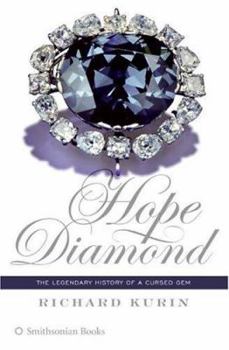Hope Diamond: The Legendary History of a Cursed Gem
Select Format
Select Condition 
Book Overview
An entertaining and well-researched history of the Hope diamond Since its discovery in seventeenth-century India, the Hope diamond, a glimmering deep blue gem weighing over 45 carats, has been... This description may be from another edition of this product.
Format:Hardcover
Language:English
ISBN:0060873515
ISBN13:9780060873516
Release Date:May 2006
Publisher:HarperCollins Publishers
Length:388 Pages
Weight:1.55 lbs.
Dimensions:1.3" x 6.4" x 9.0"
Customer Reviews
5 ratings
Good book
Published by Thriftbooks.com User , 15 years ago
This was a great book - fascinating and so interesting. I had to read it for a class, but I personally enjoyed it.
Fascinating
Published by Thriftbooks.com User , 15 years ago
This book is a must read for anyone interested in a fascinating history of a unique gem stone. I could not put it down. Research is well done. I learned a lot I did not know about the Hope Diamond.
The Real Story of the Hope Diamond
Published by Thriftbooks.com User , 17 years ago
This wonderfully researched and lively account traces the story of the Hope Diamond and in the process debunks and dispels much of the misinformation surrounding the world's most famous gem. The debunking begins on page one. Years ago I heard a story that Harry Winston shipped the Hope to the Smithsonian by regular mail in a plain brown paper wrapped package. It went by mail alright in a plain brown wrapper but it was insured for a million dollars. Kurin begins his tale at the beginning by making his own journey to northwestern India to the fabled Kingdom of Golconda and the storied mines of Kollur. This is the mine mentioned by the famed 17th Century French gem merchant, Jean-Baptiste Tavernier. Tavernier, the man who sold the diamond to Louis XIV of France was famously silent about where he obtained the stone but he does mention Kollur as a source of colored diamonds and based on that single mention, most experts have deduced that Kollur was the source. What did he find in Kollur? Snakes! After a difficult three day journey following Tavernier's route by car, snakes and very little else. There exists barely a trace of the old mines which were played out and abandoned in the 18th century. The presence of snakes together with a nearby mountain and bit of local folklore leads Kurin to speculate that perhaps, Kollur was the site of the original Valley of the Serpents mentioned by Marco Polo. A bit of a leap, perhaps, unlike Mogok, Kollur isn't a deep valley but the locals do have a two-headed bird god and that is something the Burmese contender lacks. Kurin pulls together an interesting, if flawed, argument for India's Kollur as the source of the Hope. He points out that when Tavernier sold the stone to the Sun King, the Hope was barely fashioned, almost rough. From this he concludes that the stone was purchased at the mines. His next conclusion is a bit more of a reach. With the meticulous attention to detail that he demonstrates throughout, Kurin discovered a short note by Tavernier on the original chart made up by the French gem merchant, describing number six of the best twenty stones Tavernier sold to the French monarch in 1668. "C'est un autre diamante que j'achetais l'an 1653 a la mine de Coulour." Taking this statement and the fact that there are no other stones immediately adjacent to that bit of text, the author speculates that the autre diamond, to which Tavernier refers, may be the blue and if so, Kurin concludes, it was purchased in 1653 at Kollur. The question is; to which diamond does the note refer and was number six simply another diamond purchased or another diamond purchased at Kollur? The passage can be read either way. The note, as Kurin points out, was not next to the Hope which was number one on the list. To that I would add two additional points that pose certain difficulties in accepting Kurin's speculations: First, number six is a colorless diamond and both the stones, numbers five and seven, immediately adjacent t
Great historical account through the eyes of a gem...
Published by Thriftbooks.com User , 17 years ago
The first few chapters dragged a bit but I guess necessary to debunk popular myth. It was very interesting to see the story of the diamond as it was manipulated by royalty, governments, businessmen, owners and media. We used it for our bookclub.
Diamond Daze Clarified
Published by Thriftbooks.com User , 17 years ago
Most people who have visited the Smithsonian have peered into the secure exhibit space to view the Hope Diamond. Most are surprised at how relatively small the diamond is, but the mystique and aura of the gem makes the wait through the long line worthwhile. Furthermore, the history, stories, and folklore associated with the stone often further piques the visitor's curiosity. This book more than satisfies this curiosity, and Kurin provides a well-written presentation of various stories and beliefs associated with the gem. Kurin takes the reader through an interesting history that details how it was discovered, traded, given away, and eventually accessioned at the museum. It's a fun read for anyone interested in history, folklore, gemology, and museum practice.





